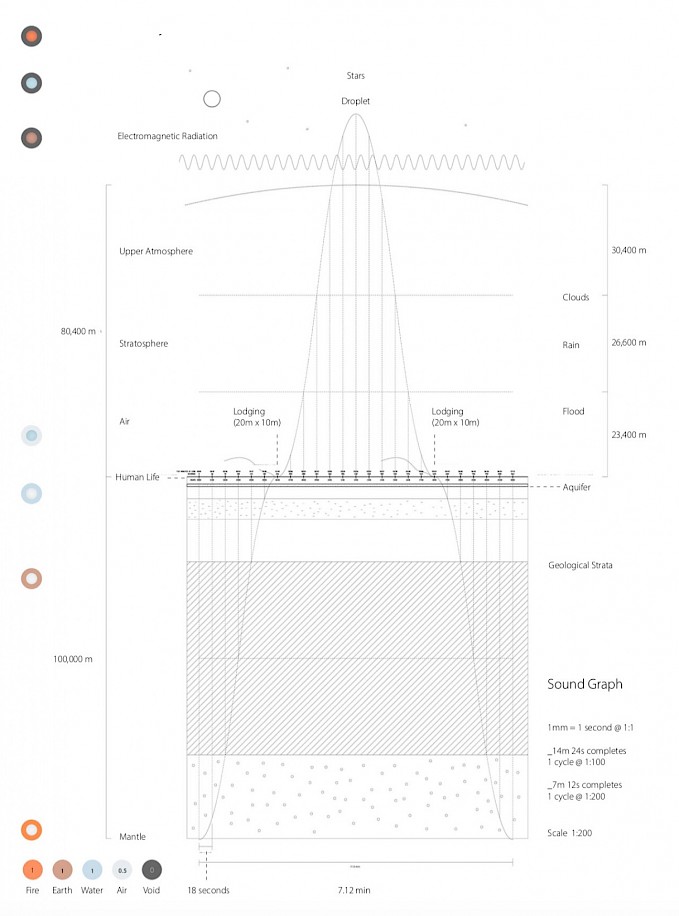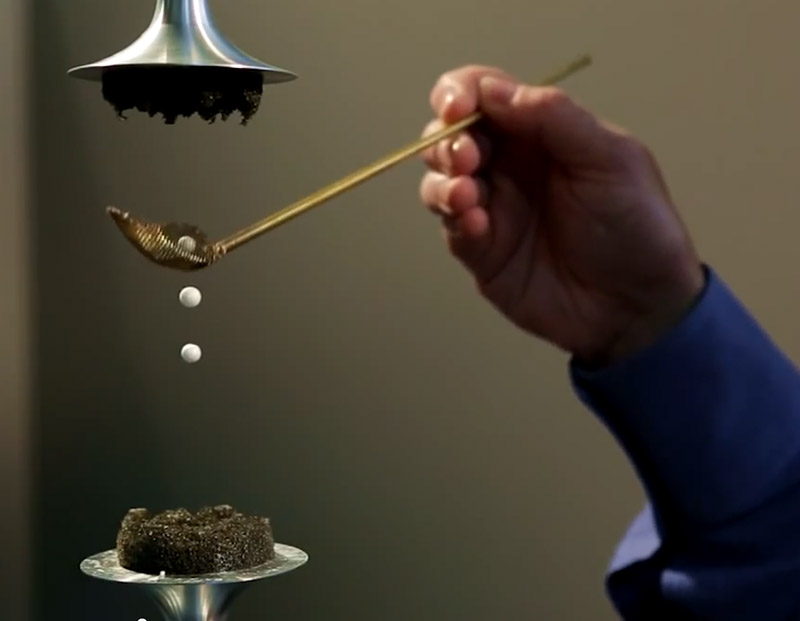The Droplet / Desert Plinth
Sound Section @ 1:200
What if a building had a digital counterpart?
A sound object that revealed layers of why something exists - invisible but influential, communicating the deeper meaning behind the object, or in this case a dwelling, to help contextualise our perception of it?
I was hugely fortunate to be asked by Yeoryia Manolopoulou and Anthony Boulanger of AY Architects to contribute to a multi-disciplinary team designing a small lodging in the Saudi Arabian desert.
The contribution was something that allows the site, the proposed building and the ideas that informed its conception to be experienced beyond its physical reach, communicated through digital means for more people to be able to share in what the building is and what it represents.
Al-Ula Sound Approach
The Value of Digital
Where do we place value?
Be it the awareness of dwindling resources around us, the rise of a digital non-physical realm, or the concept of ownership, the answer to this question is shifting.
More and more of our lives are online. For example, the phone as an object is becoming less important relative to the information that lives within it - infomation that makes that object 'ours'.
The scarce and expensive is being augmented and sometimes replaced by the ubiquitous and cheap via economies of scale and digital replicability. The evidence is in the shifting focus of companies and economies to software, services and interoperability. To paraphrase the artist Bill Viola,
"Digital innovation represents the greatest invention. You can now see the invisible root structure - the space underneath the image. The visual surface is not telling the truth. As such the visual image isn't enough, it is inadequate, because it doesn't show us the invisible things, the connections."
However, there is no digital substitute for what water does for the human condition. Information flows through us, it keeps us engaged, but it can't keep us alive. Thus it is and will remain an ever more precious resource and the focus of this project.
The Value of Sound
In conjunction with image, sound gives us transparency.
It is integral to a sense of place and orientation. Like peripheral vision, it frames our experience and along with our other long-range sense - sight - gives us a sense of the context of our immediate environment. As it exists in time it shows us how components connect and interact, a crucial part of bringing us a deeper understanding and something impossible in representations that do not move.
This is why, for evolutionary reasons, sound is our fastest sense. We process sounds about 3-4 times faster than images. Sound is therefore more visceral and immediate, allowing us to 'see' in the dark.
For this project, the emphasis on sound is really a question about the boundaries of a building. As described in the submission:
A sonic distillation of the concepts that underpin our strategy, and developed in collaboration while the building was being designed, it aims to exist in memory as well as in physical form as a way to redraw these boundaries and a sense of what a building can be. Appropriately, as sound is our fastest sense, the reach of the digital sonic component is global and instant. As it was developed as part of the design process it is not a signature or a response but rather part of its DNA.
The building is a focal point in the landscape, a place where the four elements : Air / Fire / Water / Earth can be manipulated, controlled and interacted with. Referencing scale, material, water, mathematics, time, history, language, rotation, tramsparency, strata, environment and technology, the sound object is built around the following parameters:
1. The geometry of a pure sine wave
2. The design of the dwelling
3. The natural and man-made forces that shape the site and the building at Al-Ula
4. The diurnal / nocturnal oscillation
5. The interplay between inside and outside
From a narrative point of view, sound as a studyable discipline is very new - it's barely been a hundred and fifty years since recording was invented. Up until that point you couldn't study it because you can't write it down. Too many variables, a language with a million letters. As a result is was invisilbe and therefore largely deemed unimportant.
The first sound recording was in 1857 by Edouard-Léon Scott de Martinville in France but the first phonograph that allowed for the reproduction of sound was in 1877 by Thomas Edison. The first movie with sound which is when the majority of the public were exposed to it for the first time wasn't until 1927 with The Jazz Singer, not even a hundred years ago.
Music on the other hand has been recorded through writing for millenia with just a series of 12 repeating notes in the traditional Western chromatic scale. An alphabet with 12 letters is much easier to work with.
Pierre Schaeffer and other pioneers of Musique Concrète captured sound in the 1940s and used it in their compositions but they still couldn't write it down. John Cage also added the element of chance to his work in the 1950s and often delegated many decisions to the players who played his work - again it was also impossible to write exactly what he meant other than creating the arena for something to happen.
But with recording you didn't need to any more. Pierre Schaeffer laid the groundwork for sampling, an invention that allowed people who hadn't had a traditional music education but had a bit of creativity to create something new.
Even the composer Igor Stravinsky acknowledged the potential for “creating music in a way that will be peculiar to the gramophone record”.
The important thing was that at least now with recording, sound was no longer invisible - it could have value. So this brand new discipline was an expanded language that carried materiality, space, gesture, environment, orientation and the relationships between objects as well as emotion. A sample carries information about it's recorded history in addition to the music it contains, a memory of its creation and prior use.
So as a non-physical material sound can absolutely be harnessed with music to communicate the essence of a design, a philosphy, a moment, a place, an intention, an action, which is...very architectural.
The Sound Section
Standing on the site you can see for miles in the horizontal plane. A 'sound section' was developed to bring this concept to the vertical plane, encompassing the site and environment as well as the dwelling.

Sound Section @ 1:200
1:1 = 24 Hours / 86,000 Seconds : 1:200 = 7 Minutes, 12 Seconds / 432 Seconds
The vision for the final version of this piece will be in surround sound to immerse listeners in both the internal and external environments of Al Ula and the elements that have, and continue, to shape it. The aim is to bring a much richer sense of place, enclosure and openness. The final piece would also be longer to evoke a more planetary rather than human scale.
This would be achieved with field recordings of the site in different weather conditions, interior recordings of the dwelling, and various recordings of site-specific human activities, flora and fauna.
I would also incorporate some frequencies beyond the range of human hearing (20,000Hz) which allows a phenomenon known as acoustic levitation to occur: the ability of a standing wave (also a sine wave) to hold a droplet of water suspended in mid-air. This typically happens at 40,000Hz.
With this frequency already embedded halfway through the track at the zenith of the sine wave in the animation, the track would be connected to the levitator so that when the sound journey reaches the outer edges of the atmosphere (shown as the top of the sine wave in the diagram), a series of water droplets on a table or a bowl (that mirror the configuration of the water-collecting etched stones outside the building) would rise into mid-air objectifying this precious resource.
They would remain levitated until the sound piece 're-enters the atmosphere' at which point the sonic boom of the thunderclap disrupts the equilibrium of the standing wave causing the drops to fall as the sound of rain appears - to be collected and consolidated ready for the next cycle.

The suspended droplets would be lit from above or below so would glow in the dark. The way the levitator currently works is that the drops are manually placed in the node points with a spoon.
When the spoon with the droplet passes through a node point created by the standing wave, it 'sticks' to that position and remains held there until the wave is moved or turned off. Think of it as the same action as lighting a candle. But with water. As the droplet would glow it could serve the same function of illumination if there was a series of them.
This is just the first part of a sonic conversation, a living archive. Sonic contributions by visiting artists could evolve its fabric and the memory of the building, keeping it relevant and alive and hopefully serving as an ongoing source of inspiration for each new visitor.
